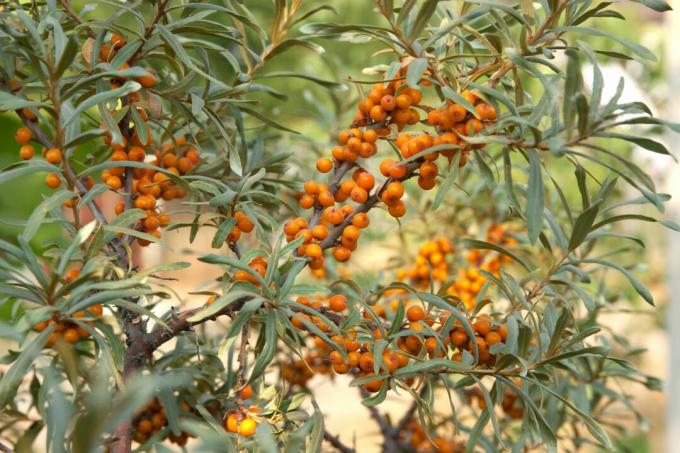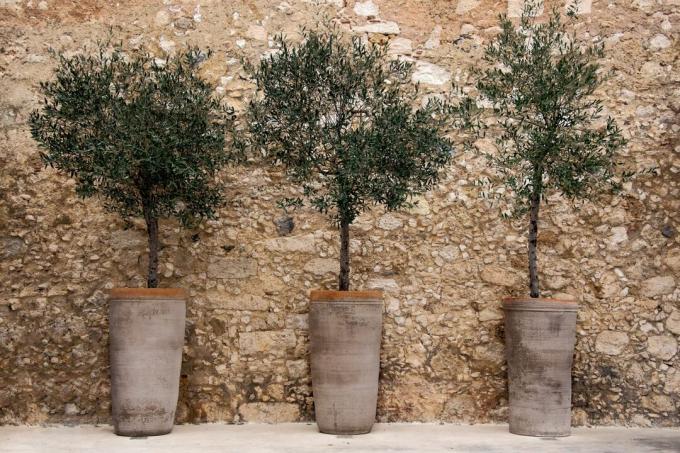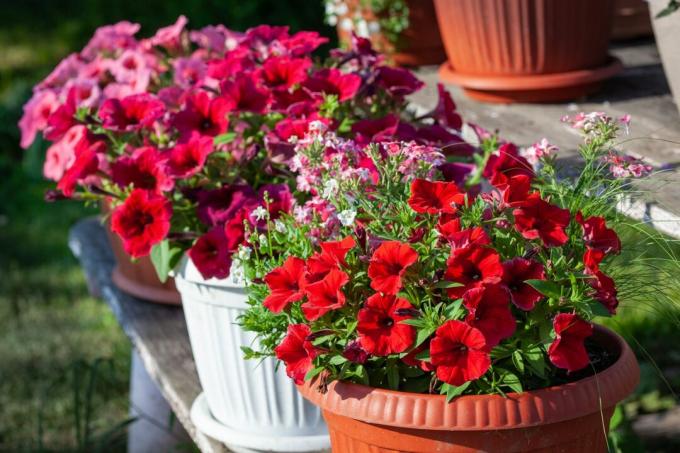Plants that tolerate heat and drought well are becoming increasingly popular. They are a way to adapt your garden and balcony to the sun and heat of climate change. Fortunately, there are more heat-resistant plants than you might think.
![Plants that tolerate extreme heat are one way to address climate change in the garden [Photo: xuanhuongho Shutterstock.com]](/f/2eeadcb6990a71967e7ada5cd7b5e212.jpg)
It has been noticed over the last few years: the summers are getting hotter and, above all, drier, which is a problem for many other garden plants. But are there also plants that tolerate high temperatures well? Yes, because not all plants are affected by heat. Some even require high temperatures for good growth. In this article we will introduce you to heat-resistant perennials, vegetables, herbs, trees and flowers.
Tip: Many heat-resistant plants have evolved to adapt to heat. They use more efficient types of photosynthesis, which can still run smoothly even in dry conditions and high temperatures. These plants use the C4 or CAM metabolism, and are accordingly called C4 and CAM plants. What this is all about is explained in more detail at the end of this article.
contents
- 1. sea buckthorn
- 2. broom
- 3. olive tree
- 4. trumpet tree
- 5. Lots of Mediterranean herbs
- 6. geranium
- 7. petunia
- 8. yucca
- 9. artichokes
- 10. aubergine
- 11. Corn
- Why is heat harmful and how do heat-resistant plants protect themselves?
1. sea buckthorn
sea buckthorn (Hippophae rhamnoides) has become more and more common in our gardens in recent years. This is due on the one hand to its very healthy fruits, which are a real regional superfood, and on the other hand to its robust, heat- and drought-tolerant nature. If you want to grow sea buckthorn for its fruit - and not just as an ornament - you should consider the following. Either you plant a female and a male variety or directly a specially bred, self-fertile variety. Because, as a rule, sea buckthorn is dioecious. This means that there are all-female and all-male flowering specimens of this species. In the garden, sea buckthorn prefers loose, well-drained, sandy soil and a location in full sun. However, it can also be grown well in large containers of at least 60 cm in diameter.

2. broom
The genus gorse (Genista) includes several subspecies. Most of these are (semi-)shrubs and, depending on the species, reach heights of between 40 cm and 2 m. Since it originally comes from the Near East, broom is one of the shrubs that tolerate heat and drought well and can cope with poor soil. Despite everything, gorse impresses with its rich, mostly yellow, orange or reddish flowers. If you grow gorse at home, which by the way also works in a pot, you have to keep the following in mind: all parts of the gorse are poisonous to both humans and animals.

Tip: Other genera that belong to the same plant family of legumes (Fabaceae) are sometimes referred to as broom. This includes Cytisus (also billy clover) and Ulex (gorse). Plants of these two genera also have little problem with heat and drought.
3. olive tree
With a olive tree (Olea europaea) bring the Mediterranean into your own garden or even onto your balcony. Since olive trees grow very slowly and are susceptible to frost, they can be grown here in Germany, especially as potted plants. There they only reach a height of around 2 m after many years. The evergreen plant is extremely drought and heat resistant. It grows best in sunny, warm and wind-protected locations. However, if you want to harvest olives yourself, you have to be patient for a few years, because olive trees only flower for the first time after 7 to 8 years. In addition, you should then either choose a self-pollinating variety, or grow two trees. Because as a dioecious plant species there are purely male and purely female olive trees.

4. trumpet tree
Not just the name of trumpet tree (Catalpa bignonioides) is extraordinary. Its heart-shaped leaves, numerous bell-shaped flowers and bean-like fruits, which can be up to 35 cm long, are also real eye-catchers in the garden. This makes the trumpet tree an attractive tree for your garden, not only for you, but also for many insects. They also appreciate the abundance of flowers on the trumpet tree. Although the trumpet tree prefers to grow in fresh, nutrient-rich soil, it is considered to be drought and heat tolerant and is also satisfied with less good locations. It should only get enough sun throughout the year. If you plant the trumpet tree in your garden, you should note that it is still susceptible to frost in the first five years of growth. That's why you have to protect it with suitable measures.

5. Lots of Mediterranean herbs
Many herbs that are popular with us originally come from the Mediterranean region. This makes them perfectly adapted to hot and dry conditions, as they belong to the CAM plants. This metabolic pathway keeps water losses as low as possible. For example rosemary (Rosmarinus officinalis), lavender (Lavandula angustifolia) and sage (Salvia officinalis) are among those plants that tolerate great heat. A list of more Herbs for sunny locations we have summarized in an extra article for you. These herbs prefer well-drained, lean soil. For example, ours is for growing in pots Plantura organic herbal and seed soil excellently suited. It is peat-free and comes in Blue Angel certified packaging.

6. geranium
geraniums (Pelargonium), which should actually be called pelargoniums, were previously incorrectly assigned to the genus Geranium. This error has now been corrected, but the common name geranium for the flower found on many balconies has remained. Many of the more than 250 species of pelargonium come from South Africa and are CAM plants. That is why geraniums naturally prefer sunny and warm locations for good growth and plentiful flowering. There are now a large number of cultivated varieties, so there is something for every balcony – be it hanging or standing, red, white or violet flowering or even noble geranium.

7. petunia
Even petunias (Petunia) come from South Africa and are ideal as container plants, for example for sunny balconies. Similar to geraniums, there are also many different varieties of petunias that can grow upright or hanging and flower in a wide variety of colors. Petunias grow well in high temperatures, but they also need enough water to do so. This is why petunias need regular watering and good quality, water-retaining soil like ours Plantura organic potting soil, to be cultivated. Even if petunias are mostly only grown as annuals in this country, they can be overwintered in a bright, cool place in the house. So you can enjoy their blooms on the balcony for several years.

8. yucca
Yucca Palms (yucca) can be found in many apartments as easy-care indoor plants. They belong to the CAM plants and are succulents, so they can store water well and are therefore among the plants for drought and heat. These heat-resistant plants, which belong to the agave family (Agavoideae), are native to North and Central America, where they have to cope with sometimes very harsh conditions. Even if yucca palms are primarily kept as indoor plants, they can also be outdoors, especially in summer, in a bright, warm location. After all, light is a factor that is often neglected in the house. There are even some frost-hardy yucca species that will overwinter outside and can be grown in the garden year-round. These include, for example, the thready yucca (Yucca filamentosa). Also many other succulents, such as cacti (Cactaceae) or pineapple (Pineapple sativus), are among the most heat-resistant plants.

9. artichokes
Even artichokes (Cynara cardunculus var. scolymus) are more familiar to us from the Mediterranean region. It is therefore not surprising that they are also heat-resistant plants. The artichoke is characterized by the very decorative flowers and the delicious, extremely healthy buds. When growing in the garden, you have to keep in mind that the plants need heat, but do not tolerate drought very well. Therefore, an adequate and regular water supply is important. Artichokes can be grown perennial, since only the inflorescences are harvested from them, but the plant remains. The only difficulty is getting the somewhat frost-sensitive plants through the winter.

10. aubergine
Until now it was aubergine (Solanum melongena) rarely found in German vegetable gardens. This is mainly due to the fact that growing them is a bit more demanding and eggplant plants need a lot of warmth. With the increasingly longer time of the year with high temperatures, however, cultivation is also becoming easier and easier for us. Like tomatoes, peppers and potatoes, aubergines belong to the nightshade family (Solanaceae) and need a sunny, warm location in the garden with nutrient-rich soil. While aubergines tolerate heat well, care must be taken to provide them with sufficient water, especially when it gets hot and dry in the summer. Aubergines can also be grown in pots. Our nutrient-rich, for example, is suitable for this Plantura organic tomato and vegetable soil, which is peat-free and sustainably produced in Germany. It is also advisable to place the plants on a sunny stone wall or house wall that stores heat well.

Tip: With many types of vegetables, a lack of water becomes a problem even before the heat in the summer. To reduce evaporation from the ground, a layer of mulch can be applied around the plants. Grass clippings or straw can be used for this. In the perennial border you can also rely on bark mulch, such as our high quality Plantura organic pine bark. This is sustainably produced in Europe and protects the soil from drying out while naturally suppressing weed growth.
11. Corn
Corn (Zea mays) is one of the C4 plants mentioned above, so it can grow more efficiently in warm weather than, for example, wheat or other temperate cereals. In most cases, however, only varieties that are suitable as animal feed or that migrate to biogas plants due to their high energy content are grown on fields. But corn as a grain can also be an important part of the diet for us humans. This is evident in its area of origin in Central America, where corn has long been a staple food, comparable to our wheat. This heat hardy plant is rarely found in a typical vegetable garden, but it is easy to grow there. Maize is also very suitable for mixed cultivation, for example with beans. Although corn loves warmth, it has high water requirements during flowering and cob formation. If there is no sufficient supply, often only half-dressed cobs develop.

Why is heat harmful and how do heat-resistant plants protect themselves?
Plant leaves have tiny openings, the so-called stomata, through which gas exchange takes place - CO2 gets into the plant and oxygen is released along with water. On the one hand, this is a necessary process, since it is the drive for water transport within the plant and water is a metabolic product of photosynthesis. On the other hand, it means that there must be water in the ground for a continuous supply of water. When it is hot, which usually also means drought, water losses through evaporation increase. But the water supply in the soil is also running out. In the event of drought stress, most plants from our latitudes therefore have to stop photosynthesis. Because they close their stomata to stop the water loss. Many plants then let their leaves hang down to offer less surface area for the sun to attack. C3 plants, which include most of our native plants, choose this path. In itself this is not a disadvantage, but only shows their evolutionary adaptation to our temperate and rainy climate.

Plants that tolerate extreme heat have adapted with more efficient water use. For example, C4 plants, which can still carry out photosynthesis very well even with narrowed stomata. Representatives of C4 plants are corn (Zea mays) and millet (Panicum miliaceum).
CAM plants save even more water because they only open their stomata at night when it is cooler. However, this also means that these plants usually grow more slowly. They traded rapid growth for sure survival.

Other ways that plants protect themselves from too much heat and too much evaporation are, for example, thick leaves with a layer of wax or a reduced number of leaves. Because the larger the leaf area is in relation to the leaf mass, the larger the evaporation area. Cacti have taken it to the extreme, which no longer have any leaves and only carry out photosynthesis with their green sprout. The effects of climate change include not only heat but also drought. We'll give you tips on how to Save water in the garden can.



